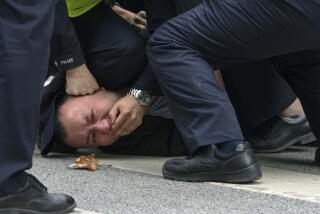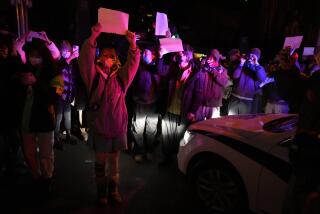Protests Spark Unrest in Shanghai, Canton, Other Chinese Cities
- Share via
SHANGHAI — The chaos that has gripped the Chinese capital for the past week has spread swiftly to the south and east, sparking major unrest here in China’s largest city and industrial hub and infecting even the country’s deep south, where Canton was brought to a virtual standstill by demonstrators Monday.
In Shenzhen, a thriving new city near China’s frontier with Hong Kong, more than 100,000 protesters--a fifth of the population--marched through the streets, chanting for democracy and calling for the firing of Premier Li Peng.
Like their contemporaries in Beijing and elsewhere in the north, the demonstrators appear to sense victory. “We have the old men on the run,” a student in Canton said. “There’s no turning back now.”
Here in Shanghai, an east China city of 12 million people, thousands of people have taken to the streets every day for nearly a week, with their ranks swelling each evening after workers end their shifts.
The unrest inflicts rising economic losses and could even trigger strikes, in the view of foreign diplomats and some workers.
“We are angry,” said a worker from an affiliate of the huge Baoshan steel plant as he stood in front of Communist Party headquarters in a driving early morning rain.
“We are showing up for work but we don’t do anything. Morale is very low.”
China’s factories are known for overstaffing and inefficiency, but workers said that productivity had fallen to a new low. “We are registering our protest on the job,” a truck plant worker said.
There was a special irony in the revolutionary fervor in Canton.
The city, with a population of 7 million, holds an almost mythical place in modern Chinese history--the place where Sun Yat-sen first moved to topple the Manchu Dynasty in 1911 and where the fledgling Chinese Communist Party organized its first strikes and protests in the early 1920s.
Cantonese students are well aware of the city’s special status, and they deliberately staged the focus of their protest near the Sun Yat-sen memorial hall.
By late afternoon, protest leaders decided to bring Canton to a near-halt. They ordered the protesters to break up into groups of a few hundred each and to march through the main streets, meeting each other at major intersections and disrupting as much traffic as possible. As they did so, most sang a well-known marching song of the 1930s, the time when China was menaced by the Japanese:
“Our beloved land is now in serious danger,” a student translated the song’s lyrics. “If all the people of the country join in the fight, then there will be hope, and we will succeed.”
Liu Jianqing, a 23-year-old woman law student, said: “We sang that and drove out the Japanese. With this song, we will drive out the despots who are ruining this country with their corruption and their incompetence.”
At Shenzhen, where the march was organized by the University Students’ Union, one police officer mounted a platform and shouted pro-democracy slogans as 200 of his colleagues and the protesters watched. “Down with Li Peng!” and “I support the students!” he shouted.
Other police officers watched as the crowd sang patriotic songs and listened to speeches supporting the pro-democracy movement.
A young man from Dong Guan, near Shenzhen, watched the march and said, “Even in my village we have heard of and support the students’ campaign in Beijing.”
More to Read
Sign up for Essential California
The most important California stories and recommendations in your inbox every morning.
You may occasionally receive promotional content from the Los Angeles Times.













